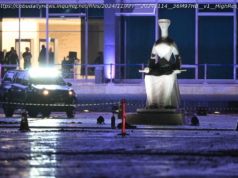Hard choices have to be made
WASHINGTON — Consider this hypothetical:
It’s a bright, sunny day and you’re alone in your spanking new self-driving vehicle, sprinting along the two-lane Tunnel of Trees on M-119 high above Lake Michigan north of Harbor Springs. You’re sitting back, enjoying the view. You’re looking out through the trees, trying to get a glimpse of the crystal blue water below you, moving along at the 45-mile-an-hour speed limit.
As you approach a rise in the road, heading south, a school bus appears, driving north, one driven by a human, and it veers sharply toward you. There is no time to stop safely, and no time for you to take control of the car.
Does the car:
A. Swerve sharply into the trees, possibly killing you but possibly saving the bus and its occupants?
B. Perform a sharp evasive maneuver around the bus and into the oncoming lane, possibly saving you, but sending the bus and its driver swerving into the trees, killing her and some of the children on board?
C. Hit the bus, possibly killing you as well as the driver and kids on the bus?
In everyday driving, such no-win choices are may be exceedingly rare but, when they happen, what should a self-driving car — programmed in advance — do? Or in any situation — even a less dire one — where a moral snap judgment must be made?
It’s not just a theoretical question anymore, with predictions that in a few years, tens of thousands of semi-autonomous vehicles may be on the roads. About $80 billion has been invested in the field. Tech companies are working feverishly on them, with Google-affiliated Waymo among those testing cars in Michigan, and mobility companies like Uber and Tesla racing to beat them. Automakers are placing a big bet on them. A testing facility to hurry along research is being built at Willow Run in Ypsilanti.
There’s every reason for excitement: Self-driving vehicles will ease commutes, returning lost time to workers; enhance mobility for seniors and those with physical challenges, and sharply reduce the more than 35,000 deaths on U. S. highways each year.
But there are also a host of nagging questions to be sorted out as well, from what happens to cab drivers to whether such vehicles will create sprawl.
And there is an existential question:
Who dies when the car is forced into a no-win situation?
“There will be crashes,” said Van Lindberg, an attorney in the Dykema law firm’s San Antonio office who specializes in autonomous vehicle issues. “Unusual things will happen. Trees will fall. Animals, kids will dart out.” Even as self-driving cars save thousands of lives, he said, “anyone who gets the short end of that stick is going to be pretty unhappy about it.”
Few people seem to be in a hurry to take on these questions, at least publicly.
It’s unaddressed, for example, in legislation moving through Congress that could result in tens of thousands of autonomous vehicles being put on the roads. In new guidance for automakers by the U. S. Department of Transportation, it is consigned to a footnote that says only that ethical considerations are «important» and links to a brief acknowledgement that «no consensus around acceptable ethical decision-making» has been reached.
Whether the technology in self-driving cars is superhuman or not, there is evidence that people are worried about the choices self-driving cars will be programmed to take.
Last year, for instance, a Daimler executive set off a wave of criticism when he was quoted as saying its autonomous vehicles would prioritize the lives of its passengers over anyone outside the car. The company later insisted he’d been misquoted, since it would be illegal “to make a decision in favor of one person and against another.”
Last month, Sebastian Thrun, who founded Google’s self-driving car initiative, told Bloomberg that the cars will be designed to avoid accidents, but that “If it happens where there is a situation where a car couldn’t escape, it’ll go for the smaller thing.”
But what if the smaller thing is a child?
How that question gets answered may be important to the development and acceptance of self-driving cars.
Azim Shariff, an assistant professor of psychology and social behavior at the University of California, Irvine, co-authored a study last year that found that while respondents generally agreed that a car should, in the case of an inevitable crash, kill the fewest number of people possible regardless of whether they were passengers or people outside of the car, they were less likely to buy any car “in which they and their family member would be sacrificed for the greater good.”
Self-driving cars could save tens of thousands of lives each year, Shariff said. But individual fears could slow down acceptance, leaving traditional cars and their human drivers on the road longer to battle it out with autonomous or semi-autonomous cars. Already, the American Automobile Association says three-quarters of U. S. drivers are suspicious of self-driving vehicles.
“These ethical problems are not just theoretical,” said Patrick Lin, director of the Ethics and Emerging Sciences Group at California Polytechnic State University, who has worked with Ford, Tesla and other autonomous vehicle makers on just such issues.
While he can’t talk about specific discussions, Lin says some automakers “simply deny that ethics is a real problem, without realizing that they’re making ethical judgment calls all the time” in their development, determining what objects the car will «see,» how it will predict what those objects will do next and what the car’s reaction should be.
Does the computer always follow the law? Does it slow down whenever it «sees» a child? Is it programmed to generate a random «human» response? Do you make millions of computer simulations, simply telling the car to avoid killing anyone, ever, and program that in? Is that even an option?
“You can see what a thorny mess it becomes pretty quickly,” said Lindberg. “Who bears that responsibility?… There are half a dozen ways you could answer that question leading to different outcomes.”
Automakers and suppliers largely downplay the risks of what in philosophical circles is known as “the trolley problem” — named for a no-win hypothetical situation in which, in the original format, a person witnessing a runaway trolley could allow it to hit several people or, by pulling a lever, divert it, killing someone else.
In the circumstance of the self-driving car, it’s often boiled down to a hypothetical vehicle hurtling toward a crowded crosswalk with malfunctioning brakes: A certain number of occupants will die if the car swerves; a number of pedestrians will die if it continues. The car must be programmed to do one or the other.
Philosophical considerations, aside, automakers argue it’s all but bunk — it’s so contrived.
“I don’t remember when I took my driver’s license test that this was one of the questions,” said Manuela Papadopol, director of business development and communications for Elektrobit, a leading automotive software maker and a subsidiary of German auto supplier Continental AG.
If anything, self-driving cars could almost eliminate such an occurrence. They will sense such a problem long before it would become apparent to a human driver and slow down or stop. Redundancies — for brakes, for sensors — will detect danger and react more appropriately.
“The cars will be smart — I don’t think there’s a problem there. There are just solutions,» Papadopol said.
Alan Hall, Ford’s spokesman for autonomous vehicles, described the self-driving car’s capabilities — being able to detect objects with 360-degree sensory data in daylight or at night — as “superhuman.”
“The car sees you and is preparing different scenarios for how to respond,” he said.
Lin said that, in general, many self-driving automakers believe the simple act of braking, of slowing to a stop, solves the trolley problem. But it doesn’t, such as in a theoretical case where you’re being tailgated by a speeding fuel tanker.
Should government decide?
Some experts and analysts believe solving the trolley problem could be a simple matter of regulators or legislators deciding in advance what actions a self-driving car should take in a no-win situation. But others doubt that any set of rules can capture and adequately react to every such scenario.
The question doesn’t need to be as dramatic as asking who dies in a crash either. It could be as simple as deciding what to do about jaywalkers or where a car places itself in a lane next to a large vehicle to make its passengers feel secure or whether to run over a squirrel that darts into a road.
Chris Gerdes, who as director of the Center for Automotive Research at Stanford University has been working with Ford, Daimler and others on the issue, said the question is ultimately not about deciding who dies. It’s about how to keep no-win situations from happening in the first place and, when they do occur, setting up a system for deciding who is responsible.
For instance, he noted California law requires vehicles to yield the crosswalk to pedestrians but also says pedestrians have a duty not to suddenly enter a crosswalk against the light.






